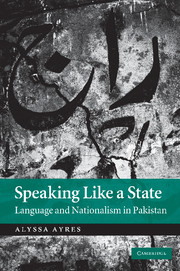Book contents
- Frontmatter
- Contents
- List of illustrations
- List of tables
- Acknowledgments
- Note on transliteration
- Introduction
- 1 Articulating a new nation
- 2 Urdu and the nation
- 3 The nation and its margins
- 4 The case of Punjab, part I: elite efforts
- 5 The case of Punjab, part II: popular culture
- 6 History and local absence
- 7 Bringing back the local past
- 8 Speaking like a state: language planning
- 9 Religion, nation, language
- 10 Conclusion
- Bibliography
- Index
1 - Articulating a new nation
Published online by Cambridge University Press: 25 August 2009
- Frontmatter
- Contents
- List of illustrations
- List of tables
- Acknowledgments
- Note on transliteration
- Introduction
- 1 Articulating a new nation
- 2 Urdu and the nation
- 3 The nation and its margins
- 4 The case of Punjab, part I: elite efforts
- 5 The case of Punjab, part II: popular culture
- 6 History and local absence
- 7 Bringing back the local past
- 8 Speaking like a state: language planning
- 9 Religion, nation, language
- 10 Conclusion
- Bibliography
- Index
Summary
This language didn't just give birth to the Pakistan Movement – it caused it to flourish, and advanced it forward. This language was the language of the War of Independence on the one hand, and on the other hand it was the medium through which science and literature were expressed.
Dr. Jamil Jalibi, Qaumī Zabān (1989)In his presidential address the “Father of Urdu,” expressing regret over Urdu's lack of status in Pakistan, said that neither Jinnah nor Iqbal had made Pakistan: rather, Urdu made Pakistan. The real reason for the opposition between Hindus and Muslims was the Urdu language. The whole Two-Nations Theory and all of the discord was only because of Urdu. For this reason, Pakistan has a great obligation to Urdu.
Item from journal Qaumī Zabān, February 16, 1961Urdu's emergence as the national language of Pakistan was neither obvious nor natural. That it became so marks the triumph of a particular understanding of the nation as a territory, a people, and a language in the singular. The choice of one language as the national language for this large territory squared neither with the broader administrative history of language under the British, nor with that of the Mughal or Sikh empires, nor with the longer histories of cosmopolitan and vernacular language use in the subcontinent. The year of independence, 1947, thus marked the beginning not only of a new political formation – a homeland founded on the basis of religion – but also of a new belief about the linguistic medium of a unitary culture in a large bounded territorial homeland.
- Type
- Chapter
- Information
- Speaking Like a StateLanguage and Nationalism in Pakistan, pp. 16 - 30Publisher: Cambridge University PressPrint publication year: 2009

